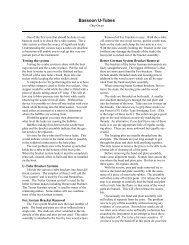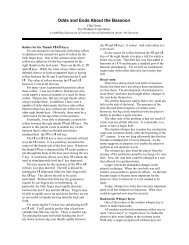Oiling a Bassoon - Fox Products
Oiling a Bassoon - Fox Products
Oiling a Bassoon - Fox Products
Create successful ePaper yourself
Turn your PDF publications into a flip-book with our unique Google optimized e-Paper software.
Spring Adjustments<br />
The C'D' trill key is an automatic mechanism and<br />
as such tends to be dependent on careful attention to<br />
spring strengths.<br />
The primary spring for the system is the heavy<br />
spring for the two-prong key. This spring functions<br />
to hold the E( vent pad closed. It must be strong<br />
enough to overwhelm the moderate spring that opens<br />
the E( Vent key. However, if it is too strong it may<br />
be difficult to equalize the feel of the thumb touches.<br />
The E( vent is sprung strong enough to open itself<br />
and must also lift the ring key. Too strong a spring<br />
on the E( vent imposes excessive demands on the<br />
two-prong key and can cause problems.<br />
The spring for the ring key can be very light. It is<br />
needed only to keep the ring down while at rest.<br />
When a plateau key is used the direction of the spring<br />
is reversed. The plateau key must be held open. This<br />
may require a slightly stronger spring that would be<br />
needed for a ring key.<br />
To adjust the spring strengths begin with only the<br />
ring key and the E( vent key in place. Be certain that<br />
the E( vent key opens without question but without<br />
excess resistance at the ring key. Next remove the<br />
ring key and add the two-prong key. Now the E( vent<br />
must be held closed without question but again do not<br />
use more spring strength than necessary.<br />
Padding & adjustment<br />
Begin by padding the E( vent key. Leave everything<br />
else out of the way. The two-prong key, the<br />
ring key and the C' lever should all be off the joint<br />
during this.<br />
Next add the ring key. The ring should close the<br />
E( vent pad and be comfortably close to level with the<br />
raised finger hole. If a plateau key is present it will<br />
need to be padded at this time. The plateau key<br />
should open about 3/32" and must close the E( vent<br />
when depressed.<br />
The two-prong key can be the most complicated<br />
part to adjust as it functionally becomes part of the<br />
lever keys above it. The objective is to get the tops of<br />
the thumb touches lined up and for them all to depress<br />
about the same distance.<br />
The use of a gauge simplifies the process. Make<br />
the gauge of rod of about 2mm diameter bent so that<br />
about ½" is at a right angle to the rest of the rod. This<br />
gauge will test for the available space under the keys.<br />
Begin by padding the lever keys. Leave the twoprong<br />
key off for now. Adjust the levels of the tops<br />
of these keys so that they coordinate with the bass<br />
keys. Ideally the high A will be the correct distance<br />
above its stop post as tested by the gauge.<br />
Install the two-prong key, the high C and the C#<br />
key. Leave off the E( vent key and the high A key.<br />
C'/D' TRILL KEY<br />
2<br />
The two-prong key should be without any cork under<br />
the two prongs. Adjust the two prongs so that they<br />
are equally in contact with the buttons on the underside<br />
of the C' and high C touches. It is also desirable<br />
if the buttons and the prongs are roughly square with<br />
each other.<br />
Now determine the correct cork thickness. Estimate<br />
the thickness of cork you will need and place it<br />
under the upper (high C) prong. Hold it in place with<br />
one of the two levers and use the gauge to check the<br />
gap between the button of the other lever and its<br />
prong. When you know the thickness that is correct<br />
or that can be sanded to the correct thickness glue it<br />
to the upper prong. There is no need for cork under<br />
the lower (C') prong.<br />
Now install the E( vent key. The lower connecting<br />
arm of the two-prong will need to be adjusted<br />
until, with the E( vent pad closed, there is a 1/64" gap<br />
under the buttons of the C' and high C keys.<br />
The gap between the high C and C' buttons and<br />
their prongs is necessary for a technique called<br />
"flicking." In this technique the thumb touches must<br />
be briefly depressed so that their vents open slightly<br />
without the E( vent pad opening. This gap allows this<br />
to happen. It is arguable that there is no need for the<br />
gap under the C' key and some players will prefer not<br />
to have it. In general it is acceptable to have a gap<br />
under both keys.<br />
Once the two-prong key is fully adjusted with the<br />
thumb touches and the E( vent pad the ring key can<br />
be replaced. At this point make sure that the foot of<br />
the ring key does not keep the E( vent pad from fully<br />
opening.<br />
With a plateau key an ideal adjustment can get a<br />
bit more difficult. Because the foot of the plateau key<br />
is always in use when the plateau is open there can be<br />
a gap between the opened E( vent key and the open<br />
plateau key. This can cause an uncomfortable double<br />
action. The solution usually involves readjusting the<br />
E( vent key to the plateau key and the readjusting the<br />
two-prong key to the E( vent key. On some instruments<br />
an ideal adjustment can be difficult to obtain.<br />
Revised October 9, 2001








